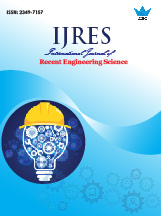Effect of Moisture Content on Nasarawu Natural Foundry Sand
Citation
MLA Style :Moses Gambo, Aje Tokan, Robinson I. Ejilah, Mbimda Ali Mbishida "Effect of Moisture Content on Nasarawu Natural Foundry Sand" International Journal of Recent Engineering Science7.4(2020):1-6.
APA Style :Moses Gambo, Aje Tokan, Robinson I. Ejilah, Mbimda Ali Mbishida. Effect of Moisture Content on Nasarawu Natural Foundry Sand International Journal of Recent Engineering Science, 7(4),1-6.
Abstract
This study was aimed at investigating the effect of moisture content of Nasarawu natural foundry sand. The moisture content was varied from 2 to 10% to determine its effect on green compressive strength, dry compressive strength, green shear strength, shatter index and green permeability. The particle size distribution, the grain fineness number and the clay content of the natural sand were also determined. The results indicated that the dry compression strength increased with moisture content, and an optimum value 99.7 psi was obtained at 10% moisture content. At the same time, 6% of moisture content gave the optimum green compressive strength of 118.6KN/m2 . Nasarawu natural sand had an average grain size of 138.73microns, clay content of 25.2% and refractoriness value of 14000C. A sand mixture containing 6% moisture was prepared and used to produce a test casting with aluminium scraps, and the cast was sound. This shows that Nasarawu natural moulding sand is suitable for a wide range of non-ferrous metal casting.
Reference
[1] N. A. Ademoh, “Evaluation of the Foundry Properties of River Niger Sand behind Ajaokuta Steel Company Limited Ajaokuta, Nigeria”, American-Eurasian Journal of Scientific Research, 3(1), 2008, 75-83.
[2] A. Tokan and S. U. Mohammed, “Determination of moulding characteristic of Dindima river sand and Alkaleri clay as a binder”, Journal of raw material, 4, 2007, 79-88
[3] W. A. Ayoola, S. O. Adeosun, A. Oyetunji and A. M. Oladoye, “Suitability of Oshogbo Sand Deposit as Moulding Sand”, The Kenyan Journal of Mechanical Engineering, 6(1), 2010, 33-41.
[4] R. K. Jain, Production Technology, Khana Publishers, Nai Sarak, Delhi, India, 16thEd, 2009, 153-158
[5] P. A. Ihom, J. A. Agunsoye, E. E. Anbua, J. Ogbodo, “Effects of moisture content on the foundry properties of Yola natural sand”, Leonardo Electronic Journal of Practices and Technologies, 19, 2011, 85-96
[6] T. N. Guma,” Characteristic foundry properties of Kaduna river sand”, International Journal of Engineering and Science, 1(11), 2012, 3-8.
[7] M. A. Mbishida and S. S. Audu, “Investigation into the suitability of Lere river bank sand for green sand casting”, American Journal of Engineering Research (AJER), 6(10), 2017, 1-5.
[8] American Foundry Men Society, Mould and core testing Handbook, 2nd edition Procedure, 1989, 74-78.
[9] A. Tokan, E. A. Adelemoni and S. G. Datau, “Mould characteristics of Azare foundry sand”, Journal and Raw Material Research, 20, 2004, 67-80.
[10] M. A. Mbishida, A. Tokan, S. A. Seth and Y. Isheni, “Investigation of Fori Natural Molding Material”, Leonardo Electronic Journal of Practices and Technologies, 32, 2018, 137- 148
[11] B. Katsina and H. K. Reyazul, “Characterization of beach/river sand for foundry application”,Leonardo Journal of Sciences, 23, 2013, 77-83.
[12] Oghenerukevwe Prosper and Mr.Hilary Uguru, "Effect of Moisture Content on Strength Properties of Okra Pod (Cv Kirenf) Necessary for Machine Design" SSRG International Journal of Mechanical Engineering 5.3 (2018): 6-11.
[13] Vema Reddy Chevuri, S.Sridhar, "Usage of Waste Foundry Sand in Concrete" SSRG International Journal of Civil Engineering 2.12(2015)
[14] B. Shuib and L. Yusuf, “Analysis of Ilorin sand moulding properties for foundry application”, International Journal of Engineering Research & Technology (IJERT), 3(1), 2014, 15-20.)
Keywords
Moisture Content, Green Compressive, Shatter Index, Green Shear


